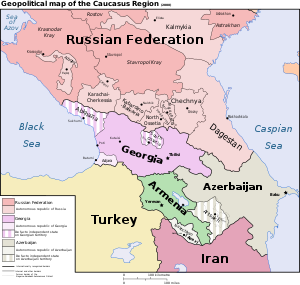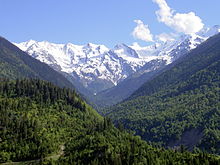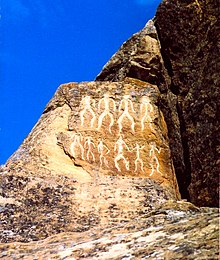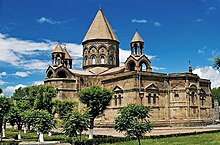This is an old revision of this page, as edited by 176.73.158.209 (talk) at 10:25, 31 May 2013. The present address (URL) is a permanent link to this revision, which may differ significantly from the current revision.
Revision as of 10:25, 31 May 2013 by 176.73.158.209 (talk)(diff) ← Previous revision | Latest revision (diff) | Newer revision → (diff) This article is about the geographic region in Eurasia. For other uses, see Caucasus (disambiguation) and Caucasia (disambiguation)
The Caucasus, also Caucas or Caucasia (for endonyms, see below), is a region at the border of Europe and Asia, situated between the Black and the Caspian Seas. It is home to the Caucasus Mountains, which contain Europe's highest mountain, Mount Elbrus. Politically, the Caucasus region is separated between northern and southern parts.
| North Caucasus | South Caucasus |
|---|---|
|
* States in italics are largely unrecognised. Abkhazia and South Ossetia are recognised as part of Georgia, and Nagorno-Karabakh is recognised as part of Azerbaijan.
Name
Pliny the Elder's Natural History (AD 77-79) derives the name of the Caucasus from the Scythian kroy-khasis (“ice-shining, white with snow”). From this Greeks called it Καύκασος (Kaukasos).

Modern endonyms
- Template:Lang-ar al-Qawqāz
- Template:Lang-av Kavkaz
- Template:Lang-cv (Aramaçi)
- Template:Lang-ce
- Template:Lang-kbd Kʺaukʺaz
- Template:Lang-pt Caucasus
- Georgian: კავკასია K'avk'asia
- Template:Lang-hy Kovkas
- Template:Lang-az
- Template:Lang-el Kàfkasos
- Template:Lang-he K'avk'az
- Template:Lang-lez K'avk'az
- Template:Lang-lbe Kkavkkaz
- Karachay-Balkar, Ossetian, Russian and Template:Lang-tt
- Template:Lang-fa Qafqāz
- Template:Lang-tr
- Template:Lang-ur Qafqāz
Geography and ecology


The northern portion of the Caucasus is known as the Ciscaucasus and the southern portion as the Transcaucasus.
The Ciscaucasus contains the larger majority of the Greater Caucasus Mountain range, also known as the Major Caucasus mountains. It includes Southwestern Russia and northern parts of Georgia and Azerbaijan.
The Transcaucasus is bordered on the north by Russia, on the west by the Black Sea and Turkey, on the east by the Caspian Sea, and on the south by Iran. It includes the Caucasus Mountains and surrounding lowlands. All of Armenia, Azerbaijan (excluding the northern parts) and Georgia (excluding the northern parts) are in South Caucasus.
The main Greater Caucasus range is generally perceived to be the dividing line between Asia and Europe. The highest peak in the Caucasus is Mount Elbrus (5,642 m) in the western Ciscaucasus in Russia, and is generally considered as the highest point in Europe.
The Caucasus is one of the most linguistically and culturally diverse regions on Earth. The nation states that comprise the Caucasus today are the post-Soviet states Georgia, Armenia, and Azerbaijan. The Russian divisions include Krasnodar Krai, Stavropol Krai, and the autonomous republics of Adygea, Karachay–Cherkessia, Kabardino-Balkaria, North Ossetia, Ingushetia, Chechnya, and Dagestan. Three territories in the region claim independence but are recognized as such by only a handful or by no independent states: Abkhazia, Nagorno-Karabakh and South Ossetia.
The Caucasus is an area of great ecological importance. The region is included in the list of 34 world Biodiversity hotspots panda.org.It harbors some 6400 species of higher plants, 1600 of which are endemic to the region. Its wildlife includes leopards, brown bears, wolves, bison, marals, golden eagles and Hooded Crows. Among invertebrates, some 1000 spider species are recorded in the Caucasus. The region has a high level of endemism and a number of relict animals and plants, the fact reflecting presence of refugial forests, which survived the Ice Age in the Caucasus Mountains. The Caucasus forest refugium is the largest throughout the Western Asian / near Eastern region The area has multiple representatives of disjunct relict groups of plants with the closest relatives in Eastern Asia, southern Europe, and even North America,. Over 70 species of forest snails of the region are endemic. Some relict species of vertebrates are Caucasian parsley frog, Caucasian Salamander, Robert's Snow Vole, Caucasian Grouse, and they are almost entirely endemic groups of animals such as lizards of genus Darevskia. In general, species composition of this refugium is quite distinct and differs from that of the other Western Eurasian refugia. The natural landscape is one of mixed forest, with substantial areas of rocky ground above the treeline. The Caucasus Mountains are also noted for a dog breed, the Caucasian Shepherd Dog (Rus. Kavkazskaya Ovcharka, Geo. Nagazi).
History
Further information: History of the Caucasus
Located on the peripheries of Turkey, Iran, and Russia, the region has been an arena for political, military, religious, and cultural rivalries and expansionism for centuries. Throughout its history, the Caucasus was usually incorporated into the Iranian world. At the beginning of the 19th century, the Russian Empire conquered the territory from the Qajars.

Under Ashurbanipal (669-627 BC) the boundaries of the Assyrian Empire reached as far as the Caucasus Mountains. Other ancient kingdoms of the region included Colchis, Iberia, Armenia and Albania among others. These kingdoms were later incorporated into various Iranian empires, including Media, Achaemenid Empire, Parthia, and Sassanid Empire. In 95-55 BC under the reign of Armenian king of kings Tigranes the Great, the Kingdom of Armenia became an empire, growing to include: Kingdom of Armenia, vassals Iberia, Albania, Parthia, Atropatene, Mesopotamia, Cappadocia, Cilicia, Syria, Nabataean kingdom and Judea. The empire stretched from the Caucasian Mountains to Egypt and from the Mediterranean Sea to the Caspian Sea, including a territory of 3,000,000 km (1,158,000 sq mi), and becoming the last strong Hellenist king, and the strongest in the region by 67 BC. By this time, Zoroastrianism had become the dominant religion of the region (except for in the Kingdom of Armenia); however, the region would go through two other religious transformations. Owing to the rivalry between Persia and Rome, and later Byzantium, the latter would invade the region several times, although it was never able to hold the region.

However, because the Kingdom of Armenia was the first nation to adopt Christianity as state religion (in 301 AD), and Caucasian Albania and Georgia had become Christian entities, Christianity began to overtake Zoroastrianism. With the Islamic conquest of Persia, the region came under the rule of the Arabs, and soon the Emirate of Armenia was formed. But after several rebellions in 884\885 AD Kingdom of Armenia became independent, and several times crushed Arab armies. At that time, the capital of the Kingdom of Armenia was Ani, with a population of 200,000 and a city of "1001 churches". It was at its peak under the reign of Gagik I, when it stretched from Byzantine Empire to Caucasian Albania, from Caucasian Iberia to Mesopotamia, including also vassal states such as Caucasian Albania and Caucasian Iberia, until in 1045 AD the kingdom was conquered by Byzantine Empire. In the 12th century, the Georgian king David the Builder drove the Muslims out from Caucasus and made the Kingdom of Georgia a strong regional power. In 1194–1204 Georgian Queen Tamar's armies crushed new Turkish invasions from the south-east and south and launched several successful campaigns into Turkish-controlled Southern Armenia. The Georgian Kingdom continued military campaigns outside of Caucasus. As a result of her military campaigns and the temporary fall of the Byzantine Empire in 1204, Georgia became the strongest Christian state in the whole Near East area. The region would later be conquered by the Ottomans, Mongols, local kingdoms and khanates, as well as, once again, Persia, until its subsequent conquest by Russia.
The region was unified as a single political entity twice – during the Russian Civil War (Transcaucasian Democratic Federative Republic) from 9 April 1918 to 26 May 1918, and under the Soviet rule (Transcaucasian SFSR) from 12 March 1922 to 5 December 1936.
In modern times, the Caucasus became a region of war among the Ottoman Empire, Iran and Russia, and was eventually conquered by the latter (see Caucasian Wars).
In the 1940s, the Chechens and Ingush (480,000 altogether), along with the Balkars, Karachays, Meskhetian Turks (120,000), Kurds and Caucasus Germans (almost 200,000) were deported en masse to Central Asia and Siberia. Eric D. Weitz wrote, "By 1948, according to Nicolas Werth, the mortality rate of the 600,000 people deported from the Caucasus between 1943 and 1944 had reached 25 percent."
Following the end of the Soviet Union, Georgia, Azerbaijan and Armenia became independent in 1991. The Caucasus region has been subject to various territorial disputes since the collapse of the Soviet Union, leading to the Nagorno-Karabakh War (1988–1994), the Ossetian-Ingush conflict (1989–1991), the War in Abkhazia (1992–1993), the First Chechen War (1994–1996), the Second Chechen War (1999–2009), and the 2008 South Ossetia War.
Tension in the Caucasus
The ethnic complexity in the Caucasus has torn many families and loved ones apart due to the unsettled differences amongst the many different ethnic groups in the area. During the last two or three centuries the region of Caucasus has been repeatedly colonized and taken over by the Russians during the soviet period. After the collapse of communism the people were looking to break away and explore their roots which have been suppressed for centuries, as a result a great deal of argumentation and dispute has poisoned the region. The different nationalities in the area include the Azeri, the Armenians, the Georgians and the Chechens. The Azeri are Turk and speak Turkish, the Armenians are Indo-European people and the Georgians and Chechens are often termed Paleocaucasians. Other groups include the Abkhaz, the Ingush, Avars, Lezgins, Karachi, the Balkans, the Nogais and the Kumyks. With as many as fifty ethnic groups, each differing in language, customs and appearance, Caucasus has been the hot spot of turbulence.
Territorial Disputes
The hostility and disputes that continue today are generated not only by religious matters, but by territorial disputes that are rooted in resentments from the past 200 years. The war between Armenia and Azerbaijan over Nagorno Karabakh took many homes and lives of civilians. The war took a toll on the economies of both countries, where hundreds of thousands of people were left unemployed. Four years of attempts by Moscow to control the situation from 1988-1992 resulted only in increased violence with anti-Armenian pogroms in Sumgait and Baku in 1988. In 1990, Soviet troops led a massacre of civilians in Baku and in 1992, they massacred thousands of Azerbaijani civilians in the Karabakh town of Khojaly. In mid-1992, a serious war broke out. The wars in South Ossetia and Abkhazia left Russian troops in control with the Organization for Security and Cooperation in Europe (OSCE). Thousands died in these ethnic tensions. Today Azerbaijan must care for 780,000 refugees and internally displaced people in the area. Over 250,000 ethnic Georgians have been displaced and thrown out of Abkhazia. Over 1.3 million people have been displaced in the Caucasus region.
Demographics
Main article: Peoples of the Caucasus Further information: Languages of the Caucasus

The region has many different languages and language families. There are more than 50 ethnic groups living in the region. No less than three language families are unique to the area, but also Indo-European languages, such as Armenian and Ossetic, and the Turkic language Azerbaijani are local and used in the area. Russian is used as a common language.
Today the peoples of the Northern and Southern Caucasus tend to be either Eastern Orthodox Christians, Oriental Orthodox Christians, or Sunni Muslims. Shia Islam has had many adherents historically in Azerbaijan, located in the eastern part of the region.
Mythology
In Greek mythology the Caucasus, or Kaukasos, was one of the pillars supporting the world. After presenting man with the gift of fire, Prometheus (or Amirani in Georgian version) was chained there by Zeus, to have his liver eaten daily by an eagle as punishment for defying Zeus' wish of not giving the "secret of fire" to humans.
The Greek hero Jason sailed to the west coast of the Caucasus in pursuit of the Golden Fleece, and there met a daughter of King Aeëtes of Colchis - Medea. The Roman poet Ovid placed Caucasus in Scythia and depicted it as a cold and stony mountain which was the abode of personified hunger and struggle.
Energy and mineral resources
Caucasus has many economically important minerals and energy resources, such as: alunite, gold, chromium, copper, iron ore, mercury, manganese, molybdenum, lead, tungsten, uranium, zinc, oil, natural gas, and coal (both hard and brown).
Sport
2014 Winter Olympics venue.
Krasnaya Polyana — a popular center of mountain skiing and a snowboard, reputed most "respectable" in Russia.
Mountain-skiing complexes:
See also
Template:Misplaced Pages books
- North Caucasus
- South Caucasus
- Culture of Georgia
- Culture of Armenia
- Culture of Azerbaijan
- History of the Caucasus
- Islam in Russia
- Languages of the Caucasus
- Peoples of the Caucasus
- Prometheism
- Transcontinental nations
- Caucasian Emirate
- Ural Mountains
References
- Pliny the Elder. "Natural History," book six, chap. XVII
- Zazanashvili N, Sanadiradze G, Bukhnikashvili A, Kandaurov A, Tarkhnishvili D. 2004. Caucasus. In: Mittermaier RA, Gil PG, Hoffmann M, Pilgrim J, Brooks T, Mittermaier CG, Lamoreux J, da Fonseca GAB, eds. Hotspots revisited, Earth's biologically richest and most endangered terrestrial ecoregions. Sierra Madre: CEMEX/Agrupacion Sierra Madre, 148–153
- "Endemic Species of the Caucasus".
- "A faunistic database on the spiders of the Caucasus". Caucasian Spiders. Retrieved 17 September 2010.
- van Zeist W, Bottema S. 1991. Late Quaternary vegetation of the Near East. Weisbaden: Reichert.
- ^ Tarkhnishvili D, Gavashelishvili A, Mumladze L. 2012. Palaeoclimatic models help to understand current distribution of Caucasian forest species. Biol. J. Linn. Soc. 105:231-248
- Milne RI. 2004. Phylogeny and biogeography of Rhododendron subsection Pontica, a group with a Tertiary relict distribution. Molecular Phylogenetics and Evolution 33: 389–401.
- Kikvidze Z, Ohsawa M. 1999. Adjara, East Mediterranean refuge of Tertiary vegetation. In: Ohsawa M, Wildpret W, Arco MD, eds. Anaga Cloud Forest, a comparative study on evergreen broad-leaved forests and trees of the Canary Islands and Japan. Chiba: Chiba University Publications, 297–315.
- Denk T, Frotzler N, Davitashvili N. 2001. Vegetational patterns and distribution of relict taxa in humid temperate forests and wetlands of Georgia Transcaucasia. Biological Journal of the Linnean Society 72: 287–332.
- Pokryszko B, Cameron R, Mumladze L, Tarkhnishvili D. 2011.Forest snail faunas from Georgian Transcaucasia: patterns of diversity in a Pleistocene refugium.Biological Journal of the Linnean Society 102: 239-250
- Multiple Authors. "Caucasus and iran". Encyclopædia Iranica. Retrieved 2012-09-03.
- Weitz, Eric D. (2003). A century of genocide: utopias of race and nation. Princeton University Press. p. 82. ISBN 0-691-00913-9.
{{cite book}}: Cite has empty unknown parameter:|coauthors=(help) - "Caucasian peoples". Encyclopædia Britannica.
Notes
- Caucasus: A Journey to the Land Between Christianity and Islam, by Nicholas Griffin
- Small Nations and Great Powers: A Study of Ethnopolitical Conflict in the Caucasus, by Svante E. Cornell
- The Caucasus, by Ivan Golovin
- de Waal, Thomas (2010), The Caucasus: An Introduction, Oxford University Press, ISBN 0-19-539977-3
- Coene, Frederick (2009), The Caucasus: An Introduction, Routledge, ISBN 978-0-415-48660-6
Further reading
- Nikolai F. Dubrovin. The history of wars and Russian domination in the Caucasus (История войны и владычества русских на Кавказе). Sankt-Petersburg, 1871–1888, at Runivers.ru in DjVu and PDF formats.
- Gagarin, G. G. Costumes Caucasus (Костюмы Кавказа). Paris, 1840, at Runivers.ru in DjVu and PDF formats.
- Gasimov, Zaur: The Caucasus, European History Online, Mainz: Institute of European History, 2011, retrieved: November 18, 2011.
- Rostislav A. Fadeev. Sixty years of the Caucasian War (Шестьдесят лет Кавказской войны). Tiflis, 1860, at Runivers.ru in DjVu format.
- Kaziev Shapi. Caucasian highlanders (Повседневная жизнь горцев Cеверного Кавказа в XIX в.). Everyday life of the Caucasian Highlanders. The 19th Century (In the co-authorship with I. Karpeev). "Molodaya Gvardiy" publishers. Moscow, 2003. ISBN 5-235-02585-7
External links
- Ethnographic map of Caucasus
- Articles and Photography on Artsakh (Nagorno-Karabakh) from UK Photojournalist Russell Pollard
- Information for travellers and others about Caucasus and Georgia
- Caucasian Review of International Affairs—an academic journal on the South Caucasus
- BBC News: North Caucasus at a glance, 8 September 2005
- United Nations Environment Programme map: Landcover of the Caucasus
- United Nations Environment Programme map: Population density of the Caucasus
- Food Security in Caucasus (FAO)
- Caucasus and Iran entry in Encyclopaedia Iranica
- University of Turin-Observatory on Caucasus
- Circassians Caucasus Web (Turkish)
- Georgian Biodiversity Database (checklists for ca. 11,000 plant and animal species)
42°15′40″N 44°07′16″E / 42.26111°N 44.12111°E / 42.26111; 44.12111
| Countries and regions of the Caucasus | |
|---|---|
| Partially-recognized states |
